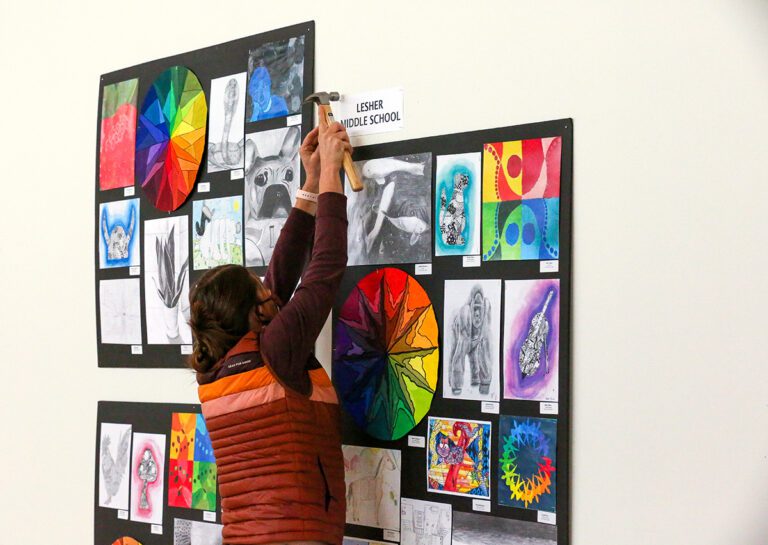During my first year of teaching, I noticed a lot of classroom teachers coming into my art room wanting supplies. Sometimes I’d be teaching, sometimes I’d be in a plan period, and sometimes I wouldn’t even be in my room. At first, I was frustrated! I didn’t want to be interrupted while I was teaching or planning. And I really didn’t like searching for a supply that disappeared when my room was vacant. It would have been so easy to let that frustration fracture the relationships I was trying to establish.
Instead, I found a way to build friendships and give the teachers in my school what they wanted — their own art supplies.

After I started to understand that the teachers in my school were simply trying to foster some creativity in their own classrooms, my frustrations started to subside. After all, the art teacher is supposed to promote art, even if it isn’t happening in the art room. So, I set out to make a space for general education teachers to get the art supplies they were craving. Follow the tutorial below to create your own, and watch friendships start to flourish with the other teachers in your school.
How to Create a Teacher Cabinet
What You’ll Need
– Signage (Lamination optional)
– A Check-out/Check-in List (Laminated)
– Vis-à-Vis Marker
– Labels
– Art Supplies
What You’ll Do
Step 1: Make Space
Clear out a cabinet in your room. I know you may need all the space you can get, but this will be a sacrifice that is well worth it. After your cabinet has been cleaned out, make two colorful signs that clearly mark your new teacher cabinet. I laminate these so they can be reused year after year.
Step 2: Create a Check-out/Check-in System
Create a check-out/check-in chart. (Lucky for you, we have one pre-made that you can download below. If you’d rather have a version you can edit yourself, click here.) I created mine on a Word document and printed it out. It’s essential that you laminate your chart so that once it fills up it can be erased and reused. You’ll want to use a pen that can be easily erased. I chose to use a Vis-à-Vis marker for easy clean-up with a damp paper towel.
Step 3: Collect Supplies
Start collecting supplies that teachers are constantly wanting to borrow. This is a slow process, but every year I try to add something new to the cabinet. Most general education teachers want paint. So, I try to stock the cabinet with multiples of every color. How do I do this? Sometimes when I get halfway through a bottle of paint, I just put the other half in the teacher cabinet. It’ll last a while because they don’t go through supplies like we art teachers do. I also make classroom sets of supplies like brushes, watercolor trays, oil pastels, crayons, and paint containers. Then you might add some unique supplies like a pipe cleaners and a hot glue gun set. If you don’t have extra money in your budget, don’t fear! The teacher cabinet is an excellent place for those random donations you get (26 doilies? Teacher cabinet! One set of off-brand watercolors? Teacher cabinet! 3 skeins of green yarn? Teacher cabinet!).
Step 4: Label Supplies
Label your supplies so they are easy to find and return. You may also want to keep a running list of what you start the school year with. This helps you to know what supplies are being used the most so you can get more.
Step 5: Train Your Colleagues
Train your teachers how to utilize the teacher cabinet. I sent out an email to my staff that was chock-full of pictures, a list of supplies in the cabinet, and how the check-out/check-in chart works.
TIP: If a teacher comes to get a supply, and it has already been checked out, he or she knows to check the chart to see who has it. It then becomes that teacher’s responsibility to return the supply once finished with it.
If you’re tired of sharing art supplies that should only be used in the art room, but you also want to have good working relationships with your classroom teachers, then consider creating a teacher cabinet. You’ll be their favorite art teacher, and you’ll ease any frustration you might have over borrowed or missing supplies.
What tips do you have for fostering good relationships with general education teachers?
How do you let teachers utilize the supplies in your classroom?
Magazine articles and podcasts are opinions of professional education contributors and do not necessarily represent the position of the Art of Education University (AOEU) or its academic offerings. Contributors use terms in the way they are most often talked about in the scope of their educational experiences.





